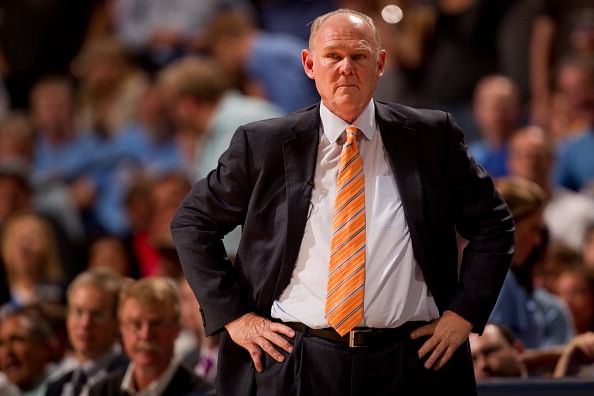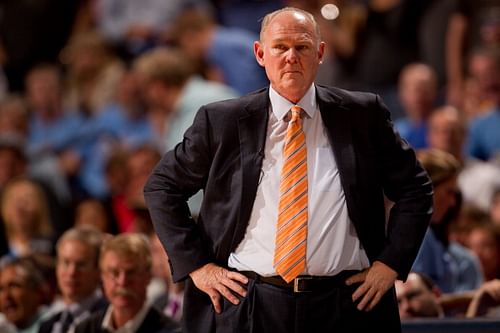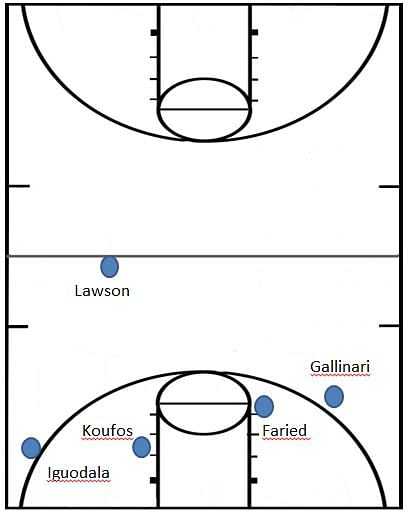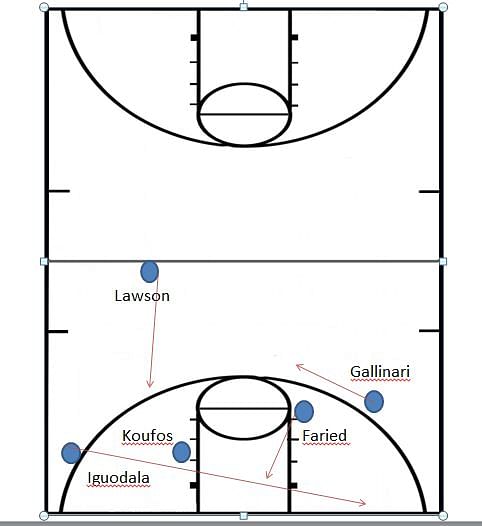
NBA Top 5 Coaches: No.5 - George Karl

He hates the Lakers, and quite rightly, because the purple and gold brigade have downed and routed him in many a play-off encounters. He isn’t a huge fan of the Spurs either, and the reason isn’t much different. A man who loves the sport beyond its implications, and whose philosophy of game-play is too varied to come down easy with the masses. Solid, hard-nosed and perseverant; the legendary basketball mastermind whose love and dedication to the sport saw him battle cancer twice, with the only hope of coaching and being involved with the game again fuelling his recovery. The man who defies physical limitations, blessed with a desire and dedication to the sport that stands unparalleled: George Karl!
George Karl has had a hypnagogic coaching career in the NBA. Over a period of 42 years, Karl has coached many NBA teams; but his golden years would definitely be his time with the Seattle Supersonics, which had the likes of Shawn Kemp and Gary Payton in the ranks, and his time with the Nuggets boasting of Melo and Billups. In all his tenure in the league, he has coasted to over 1000 wins, and has led his team to the play-offs 21 times, averaging a winning percentage of more than .500 in 20 of those seasons. If you talk stats alone, there aren’t many coaches in the history of the NBA who can hold a candle to Karl. And if you think that his struggles with cancer and health issues would have him bogged down, it is but interesting to note that since 2007, he has led the Nuggets to 4 consecutive seasons with more than 50 wins, a streak that is the second longest in Nuggets history. Also, he has led the Nuggets to the play-offs in all of the seasons he has been at the helm. Impressive stats indeed, but still not good enough for most quarters of the media.
The bromidic and hackneyed media, driven by the incessant need to place teams, players and almost everything involved with the sport into hierarchy see Karl as no hero. He doesn’t have the rings to validate his credibility; but for maybe a couple of seasons, he has seen his team bow out very early in the play-offs.
However, a quick glance at the rosters who have been led by Karl shall show that but for the few years with the Supersonics when he had the deadly duo of Kemp and Payton at his disposal and the year in Denver when he had Billups and Carmelo playing for him, he has always had to coach a roster that was devoid of star players and all-stars. The teams, in most cases, were short on experience and what George Karl did with these teams is surely remarkable. Consider the Nuggets team of today. It might have the deepest and the most talented roster on paper, but the basic core of the team is still very young and lacking play-off experience. To still manage a 7-game series against the Kobe Bryant-led Lakers can’t surely be seen as an elementary achievement.
The pundits despise his strategy, because the league has been habituated to eulogize and bedizen defensive specialists likes Larry Brown and Pat Riley. Contrast to that, the run-and-gun offensive philosophy of Karl is a vexing vicissitude.
George Karl is maybe the last preacher of the famous run-and-gun system of basketball made much famous by the enigmatic Paul Westhead in his time with Loyola Marymount. And maybe even its inventor didn’t understand the system as well as Karl did. George Karl’s teams have always known to exhibit a form of basketball that not only defies convention, but is far more direct, decisive and makes for a much refreshing telegenic. The offensive sets that he plays needn’t be played off a drawing board, because unlike rival philosophies like the Triangle or the recent Princeton offense, it is far simpler and the only thing that it requires is movement, constant motion, speed and the desire to play hard.
“The longer I’m in coaching, the thing I want most on my team is — play-hard. I think I can coach almost anything with play-hard on my side. I’ve been trying to figure out how to say this to the players, in a different language or a different way, because they’re tired of hearing it. But we will not be great without play-hard.”
Idealism from a coach whose lessons though being antediluvian are still effective. To win you just need to outscore the other team. And to score in the easiest way, you have to run and run. The whole idea is to try and force as many transition opportunities as possible, to hurt teams even before their defense gets a chance to set.
Here is a break-down of the run-and-gun version of play that the Nuggets have adopted in their time under George Karl.

The above picture is what an ideal half-court Nuggets offense looks like. PG Lawson has the choice to pass the ball to Iguodala, Gallineri or Faried. The players who receive the ball are supposed to look for a shot, and if not possible, then differ to some other option. It doesn’t matter whether it is too early on the shot-clock or how good a shooting form that player has been in. On a George Karl team, if you catch the ball and you are open, it is almost understood that you have to take the shot. It is the confidence and belief that he gives to his players. So, if Iguodala or Gallineri or Faried catch the ball, they are supposed to look for a shot first.
If the shot isn’t there, they are supposed to look for some other opening, set a back-pick and rotate to another spot. The offense is extremely smooth and marked by rapid and incessant motion. The back-picks and cuts are vital and the ball is never stagnant.
For example, if Iguodala gets the ball and can’t shoot, he will pass the ball to Koufos, allow him to get a deep post position and rotate to the baseline. Faried playing on the elbow will then make a cut to the ring, and set a back-pick for Iguodala who will use the screen to run the curl and spot up on the corner. If Koufos doesn’t get an easy look, he will kick the ball out to Lawson on the perimeter or try to find the rotating Faried for an easy lay-up or dunk. If the ball does go to Lawson, he will rotate it to Gallineri, who then has the decision to either exploit the defensive rotation or pass it to the spot-up shooter on the corner, or use a shot-fake to get to the paint.

The offense gets everyone involved, is decisive and more often than not, garners a high percentage shot. It can lead to an open three-point shot or a throw-down on a lob or even an easy score off dribble penetration. With the ball moving so quickly, the defense is always hard-pressed, and it is no surprise that the Nuggets get so many opportunities at the charity stripe.
However, Karl’s philosophy isn’t limited to the half-court sets. His offense starts from the very second the opposition team takes the shot. As soon as the Center gobbles up the rebound, he is supposed to give out an outlet pass as soon as possible to the waiting guard on the wings. And the guard is going to push the ball, with the whole team running the floor and trying to steal an easy bucket on a transition opportunity. A lob, back-pass to the trailer and throw-downs are signature plays for the team that averaged the league high in fast-break points and in overall points scored for the last campaign.
But in the utter desire to run the floor also lies the greatest frailties of George Karl’s coaching strategies. The players tend to over-anticipate and try to force turn-overs and steals. In their eagerness to force a turn-over, they generally make defensive lapses which allow the opposition to hurt them on the defensive end. Not surprisingly, the team also was the second highest in points allowed. Also, his rapid movement and insistence to run and play hard takes its toll on his teams on the long run. A major reason why his record in the regular season far exceeds his exploits in the off-season. However, he still remains fixated on his beliefs, and his demands from his players have seen his teams lack the energy and freshness come the play-offs.
In spite of the above glaring failures, their enigmatic manager isn’t ready to change his system, but rather chooses to adapt a rapid rotation policy. His desire to share and distribute the playing time on an equitable parity basis has seen 10 players in the current team average double-digit minutes. He has chosen to be unconventional in his rotation policies, deciding to play the fresher player rather than eulogize the bigger player.
A policy that saw many pundits calling for his axe when he chose to start with Koufos in place of the mercurial and extremely talented McGee. Now, the fans would want their favourite players to play the clutch minutes, but Karl is too wise to allow their fads and fantasies to waiver his beliefs and understanding. McGee is without doubt the Nuggets best center, but is still too raw to bear major responsibilities. And if you compare the minutes, both players have been averaging around 20 minutes per game. Thus, this is nothing but smart man-management from their coach, who is wise and understands the rigours of the regular season better than the fans in the galleries. His ways might not make him much popular with the fans now, but come play-off time, he knows that he would have two centers who have had decent run-ins en route to the play-offs and are fresh and geared up for a long run.
Karl is definitely a propagator of allowing the younger players minutes in games, and it is with his time that the likes of Lawson, Anthony and the much recent Faried have developed into the players that they are today. Karl instils great belief in his players, encouraging them to take shots they like, allowing them the freedom to play the way they want to, and supporting them all through. It was his faith that has fuelled the recent growth in McGee and Faried. About him holding them back and cutting down on their minutes without reason, he understands his players better than any critic, and can surely make the most of the talent around him. This is the sole reason why he insists on keeping McGee as the back-up big guy and has placed so much emphasis on developing an understanding between McGee and the perennial wizard in Andre Miller.
But Karl can’t openly move away from the large void that is a huge blotch on a rather illustrious career. He has never won a Championship, and though an explanation about him never having a team to win it all exists, for a coach of his calibre, it is banal to assume that he is satisfied with that reason. In all his years in the league, he understands the value of winning a Championship and with the new and improved Nuggets, he has a pretty good chance at achieving a significant play-off run. How far he take the Nuggets is something that will be revealed in the coming months. One can only hope that they remain fresh and fit to keep playing hard, for that is the only way their coach sees basketball. Whether they can do that for 82 games and still remain fresh to repeat the same energy in the play-offs remains to be seen.
On a more personal level, Karl remains a simplistic god-fearing man, wiser by his battle with cancer and actively involved with many cancer-related organizations. A man of heart and conviction who still shines beyond the spangles and glitter of the NBA. A legacy similar to Martin Scorsese, maybe.